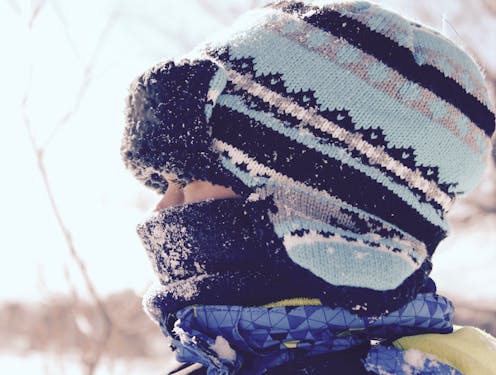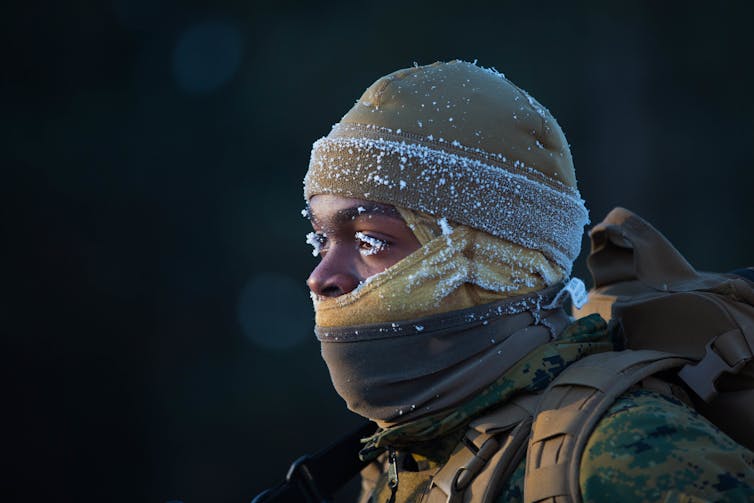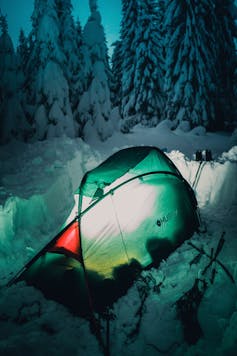It's cold! A physiologist explains how to keep your body feeling warm
Winter comes with colder temperatures. You and your body can work together to stay comfortable.

Whether waiting for a bus, playing outside or walking the dog – during the colder winter season, everyone is looking for ways to stay warm. Luckily, the process your body uses to break down foods serves as an internal heater.
But when the weather is cold, some defensive strategies are also necessary to prevent your body from losing its heat to the surrounding environment. As the temperature difference between your warm body and its frigid surroundings increases, heat is lost more quickly. It becomes more of a challenge to maintain a normal body temperature.
And two people with the same exact body temperature in the same exact environment may have very different perceptions. One may feel frozen while the other is completely comfortable.
But beyond the subjective experience of coldness, researchers do know that natural physiological responses to cold as well as behavioral adaptations – like bundling up! – can help keep your body around 98.6 degrees Fahrenheit and make sure you feel warm.

What your body does
Your blood courses through your body carrying nutrients, oxygen and other biological important substances. And this delivery system also brings heat produced in the muscles to the skin, where it’s released.
When you enter a cold environment, your body redistributes blood to the torso, protecting and maintaining the warmth of the vital organs there. At the same time, your body constricts blood flow to the skin. Narrowing the roads to the skin means less heat can make the journey, and so less is lost to the environment. And minimizing how much blood goes to the skin – which is in closest proximity to the cold – means you can hold onto more of your internal heat longer.
Another defensive strategy the body uses to stay warm is cranking up muscle activity. This in turn increases your metabolism and creates more heat. Think of a brisk winter walk when the mercury has really plunged – your teeth may chatter and your arms and legs may shake uncontrollably in shivers. This seemingly nonproductive use of the muscles is actually an effort to increase body temperature by breaking down more nutrients to stoke your internal furnace.
Differences in body size, body fatness and metabolic activity influence how different individuals experience cold. Smaller people with lower levels of body fat lose more heat to the environment than larger people with more body fat. A bigger individual may have increased muscle mass, which is a producer of heat, or elevated body fatness, which functions as an insulator to reduce heat loss. These differences are not easy to change.
Things you can do
In order to maintain a feeling of warmth, you can manipulate your clothing, your activity and your food.
The most common thing people do to stay warm is wear a coat, hat and gloves. Obviously increasing clothing thickness or piling on the layers helps. Winter clothes serve not to warm you up, but more as a means to keep the heat you are producing from dispersing to the surrounding environment.
Contrary to popular belief, the head is not a greater source of heat loss than any other adequately covered body part. If you were to wear a warm hat and no coat, your torso would contribute the most to heat loss, thanks to how your body redistributes its blood in cold conditions. If you can keep your torso warm, you’ll maintain blood flow to your limbs and can often keep the arms, legs, hands and feet warm.
Secondly, being physically active causes your muscles to contract, breaking down more nutrients, which generates additional heat. This additional heat production can help maintain body temperature and the feeling of warmth. Maybe you’ve noticed this in your own life if you’ve run in place for a bit or done a quick set of jumping jacks when you’re out in the cold.
Unfortunately, physical activity or layers of clothing can tip the balance past what you need to offset heat losses. In that case, you’ll experience an increase in body temperature – and your body will start sweating in an effort to cool down. This is a bad outcome, because the evaporation of sweat will lead to greater rates of heat loss.

Finally, eating increases the body’s production of heat. The process of breaking down food is going to slightly increase body temperature. Sometimes campers will have a snack before bed in an effort to stay warmer through the night. While the metabolic impact of a small snack may not be huge, the tipping point between heat balance and heat loss is pretty small.
You may also notice the urge to urinate – what physicians call cold diuresis. It’s a side effect of constricting blood vessels and the resulting increase in blood pressure as the same amount of blood has a smaller space available to travel through your body.
And if you’re the type who tends to feel cold and leave your coat on even inside, you might want to rethink the habit. Your skin will be flush with blood as your body tries to dissipate excess heat inside. Worst of all, you may start to sweat. Once you head back out the door, you might feel even colder initially than you would have as the cold air saps the heat from your skin and your sweat evaporates. To stay comfortable, your best bet is dressing appropriately, whether inside or outdoors this winter.
JohnEric Smith has received research funding from multiple sports nutrition companies. He is a member of Dymatize Nutrition’s Advisory Board.
Read These Next
Billionaires with $1 salaries – and other legal tax dodges the ultrawealthy use to keep their riches
The richest Americans can largely avoid paying income and other taxes. A new book explains the history.
Supreme Court case about ‘crisis pregnancy centers’ highlights debate over truthful advertising stan
There are some 2,500 of these centers across the United States. Many are located within a mile of an…
Hacked phones and Wi-Fi surveillance have replaced Cold War spies and radio waves in the delusions o
The delusions of people with thought disorders have had consistent themes of persecution for decades.…





